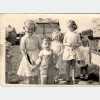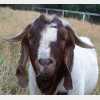| Profile | Posted by | Options | Post Date |

|
GranOfOzRubySlippers
|
Report
|
18 Nov 2009 12:40 |
|
Need some help to decipher please.
Maternal DNA
Ancient ancestry: The Ice Immigrants
Haplogroup: K
Haplogroup K, The Ice Immigrants You belong to the Ice Immigrants, haplogroup K, which emerged around 50,000 years ago and migrated from the Middle East (Near East) to Europe.
The earliest Ice Immigrants were hunter-gatherers whose lives and populations were shaped by migrations forced by the Ice Age.
Notable rates of Ice Immigrants are found among the Druze, a small and distinct religious community residing mainly in Lebanon and Israel. The Druze religion is an offshoot of the Ismaili sect of Islam.
They call themselves the "people of monotheism".
The Druze maintain a discrete court system and are officially and internationally recognized.
The Druze symbol is a five-pointed star. Each point is a different color: green is the universal mind, red is the universal soul, yellow is truth, blue is cause, and white is effect. The number five has special meaning to the Druze.
Ice Immigrants are also found among populations of the Gurage of Ethiopia, who are thought to be descended from Arabian invaders who arrived over 2,000 years ago. Of particular value to the Gurage culture is the ensete, a plant resembling a banana. The plant is a dietary staple, but also used ritualistically.
About 10% of Kurds, Palestinians and Yemenites are also Ice Immigrants.
Ice Immigrants can be found in regions as far east as Mongolia, probably representing the first Ice Immigrant migrations. It's thought that some Ice Immigrants moved from this region into Turkey and areas around the Ural Mountains.
Although present day Basque populations do not have a very high number of Ice Immigrants, tests on Basque remains from thousands of years ago reveal that at one time, Ice Immigrants made up large numbers of the population. This finding means you could share ancient ancestry with the Basques.
A unique modern day population, the Basque people self-identify as a discrete and preserved ethnic group in north-central Spain and southwestern France. Early Basque culture was basically democratic and their pre-Christian religion was formed around a superior female goddess, Mari. A rich mythology of Basque creatures and characters includes imps, giants, dragons, soothsayers and other nature-based deities. Traditional Basque cuisine was dictated by the mountains and sea surrounding Basque country.
Lamb, fish and beans are typical ingredients of a Basque meal. The language associated with the Basque people is euskara, which linguists believe exists in a family by itself, and is not related to English or other western European languages.
The Ice Immigrants are found at notable rates among populations of Ashkenazi Jews from central and eastern Europe; about 20% of today's Ashkenazi population belong to a particular Ice Immigrant subgroup, K1a1b1a.
A 5,300-year-old man was discovered in the snowy Alps near the Austrian-Italian border in 1991.
He was found to be an Ice Immigrant, not unlike many members of today's Alpine populations.
Scientists named him Otzi.
In The Seven Daughters of Eve, author Brian Sykes describes the lifestyle of the Ice Immigrants in a rich narrative surrounding their ancestral mother, whom he calls Katrine.
|

|
GranOfOzRubySlippers
|
Report
|
18 Nov 2009 12:41 |
|
Paternal DNA
Ancient ancestry: The Artisans
Haplogroup: R1b
You belong to haplogroup R1b, The Artisans, who first arrived in Europe from west Asia about 35,000- 40,000 years ago at the dawning of the Aurignacian culture. This cultural was remarkable for its subtle yet significant technological progress, like the shift from random flint collection to the use of a single stone core to shape flint tools as needed. Aurignacian decorative beads and jewelry could also be the first sign we have of the uniquely human quality of self-awareness and adornment. Additionally, some anthropologists believe that the Aurignacian culture was the first to paint. Either way, the people of this time period left behind fascinating cave paintings in France, Spain and Portugal.
Other experts believe that the Perigordian culture was prevalent at the time when the Artisans first arrived in Europe. This culture distinguished itself with different technological advances, such as denticulate tools with saw-tooth notches for cutting meat or wood and for smoothing and polishing.
There are several known subgroups of R1b. We're not yet able to tell you which (if any) of these subpopulations you match to, so we'll tell you a little about a few of them. Population genetics is a rapidly advancing field, and new data may allow us to match your DNA to a specific subgroup in the future. We'll notify you by email if more advanced results become available. One subgroup of the Artisans, R1b3 (sometimes called R1b1c) is associated with the Cro-Magnons. Based on archaeological excavations, particularly in France, it's believed that the Cro-Magnons wove clothes, built huts and painted.
The Ice Age may have played a role in the dispersion of the Artisans. At the peak of the Ice Age a European ice shelf extended as far as southern Ireland, mid England and northern Germany, completely covering Scandinavia. Most of continental Europe was tundra and the land only supported trees as far south as southern France, northern Italy and areas north of the Balkans and across the Black Sea. Thus, the Artisans most likely moved south of the tree line for their resources, making permanent homes where their descendants remained even when the ice shelf receded. Others returned north once resources were again available.
About 70% of individuals currently residing in southern England are members of the Artisans. Other members can be found at high rates in the modern day populations of Spain, Portugal, France, Wales, Scotland and Ireland. Based on this observation and other archeological and historical information, it is likely that your ancient ancestors also populated these areas. The Artisans include a genetic group known as the Atlantic Modal Haplotype (AMH), which features greatly among the Irish and Welsh populations.
Some researchers believe that the genes associated with the AMH moved with the early Celtic migrations. Although ancient ancestral Celts were a diverse group and varied in many ways, certain mythologies are consistent throughout most Celtic traditions, despite geographic or tribal boundaries. More than 300 Celtic deities have been described, many of which are reflected in classic Roman counterparts. The god Lugh (or Lugus) may have played an important role among those deities. Folklore and storytelling has infused Lugh's character with magic and fantasy, given him credit for thunder and lightening, and placed his stage in the sky.
The widespread acceptance of Lugh in Celtic culture is supported by the use of his name as the root of city names. Lyon, the present day city in southeastern France was called Lugdunum in Roman times. The city of Leiden in south Holland may also have its roots in the name of the god.
R1b1c4 and R1b1c6 are very specific Artisan subsections found primarily in Basque populations, but also in Catalan, Spanish, French, British and German populations.
A unique modern day population, the Basque people self-identify as a discrete ethnic group in north-central Spain and southwestern France. Early Basque culture was basically democratic and their pre-Christian religion was formed around a superior female goddess, Mari. A rich mythology of Basque creatures and characters includes imps, giants, dragons, soothsayers and other nature-based deities. Traditional Basque cuisine was dictated by the mountains and sea surrounding Basque country. Lamb, fish and beans are typical ingredients of a Basque meal. The language associated with the Basque people is euskara, which linguists believe exists in a family by itself, and is not related to English or other western European languages. Members of the Artisans can be found at high rates in South America. Populations geneticists ascribe this finding to the movement of peoples from Iberia to South America over the last 500 years.
|

|
AnninGlos
|
Report
|
18 Nov 2009 12:55 |
|
Wow Gail, |I see what you mean, it takes a lot of digesting. I hope somebody with a better brain than I have can elucidate on this because I find it fascinating. I have trouble even grasping the time schedule. 40000 years is a lot of years!!
So what you are saying is that you have had your DNA analysed and this is the result, is that right?
I wait for somebody with a brain and I will read it through again after I have had my lunch. (brain needs feeding obviously).
|

|
*** Mummo ***
|
Report
|
18 Nov 2009 13:00 |
|
Hi Gail, sorry l can't be of any help but just thought you might like this bit of info..........on chat* Mick from the bush *put up a thread not long ago about DNA that he had sent off, not sure exactly what the outcome was but might be worth looking at. x
|

|
AnninGlos
|
Report
|
18 Nov 2009 14:30 |
|
Surely somebody has the brain to go through this and explain, if nothing else it is very interesting.
|

|
Carole
|
Report
|
18 Nov 2009 15:08 |
|
Hi Gail, it pretty heavy stuff isn't it. Micks was also heavy reading. I wonder if the results are a bit like a horoscope ( you look for something true in there) and say oh yes that is me. It is vague in parts isn't it. ( There are several known subgroups of R1b. We're not yet able to tell you which (if any) of these subpopulations you match to).
I'd like to have my dads DNA tested, but the results I would be looking for are more recent (the last 100 years) than going back to the ice age. I'd like to know if it's true or just something my Nan made up that his father was American.
|

|
AnninGlos
|
Report
|
18 Nov 2009 15:19 |
|
Carole I think all these things we aren't used to that are technical appear heavy. I was hoping somebody more intelligent than I could help us.
|

|
SylviaInCanada
|
Report
|
18 Nov 2009 20:28 |
|
I have a degree in Genetics ...... albeit from over 40 years ago
and I just don't understand any of the findings from DNA tests
EXCEPT for the fact that they seem to have tied you to one of several groups, and your group originated in the Mediterranean area 40000 or so years ago
That group would then have moved out in other areas of Europe and Africa.
I think you need to determine where your ancestors came from, going as far back as you can, and then see if you can tie that in with anything in those results.
Obviously at some point, the maternal line of ancestors crossed paths with the paternal line!
Just be glad you haven't been tied to a Neanderthal!
|

|
SylviaInCanada
|
Report
|
19 Nov 2009 01:03 |
|
lol!!!
|

|
SylviaInCanada
|
Report
|
19 Nov 2009 01:04 |
|
I have to pass on this ...........................
OH is a science ethicist, working in the area of ethics in the scientific community (as against medical ethics)
I told him about this thread ...... and he commented that there is some concern in the science community about the ethics of the companies that offer these DNA tests.
Just something to think about
sylvia
|

|
AnninGlos
|
Report
|
19 Nov 2009 17:49 |
|
Interesting Sylvia, Is there some suspicion that they may not be genuine?
|

|
SylviaInCanada
|
Report
|
19 Nov 2009 17:58 |
|
sparklingAnn
I believe there is, but the main reason is that they are all for-profit companies, with some suspicions as to the accuracy of their work.
sylvia
|

|
Mick from the Bush
|
Report
|
19 Nov 2009 23:22 |
|
Gran - these are some of the best sites I have found-
http://www.buildinghistory.org/distantpast/peoplingeurope.shtml
http://www.dna-forums.com/index.php?/index
http://www.eupedia.com/europe/european_mtdna_haplogroups_frequency.shtml
http://www.mitosearch.org/add_start.asp?uid=yx6pb
http://www.ybase.org/submit.asp
Yes -it can be heavy going - persevere!
xxxxxxx mick
|

|
GranOfOzRubySlippers
|
Report
|
20 Nov 2009 01:03 |
|
Thanks Mick I will look at those sites, it is interesting though.
Sylvia, would love to hear more about the Ethics of all this. It is also interesting.
Gail
|

|
Mick from the Bush
|
Report
|
20 Nov 2009 01:23 |
|
Oh and Gran, if you manually enter your results on Y-search and Mitosearch it will tell you which sub-groups you belong to.
xxxxxxx mick
|

|
GranOfOzRubySlippers
|
Report
|
20 Nov 2009 03:23 |
|
Thanks Mick. Worked out Y-search but having trouble with Mitosearch.
Hard going alright, should have studied this stuff instead of accounting.
Gail
|

|
SylviaInCanada
|
Report
|
20 Nov 2009 03:42 |
|
Hi Gail
one of the ethical concerns is the protection of your DNA and data
most of these companies do not seem to have good protection, so your information could be released into the world wide community.
One company that was offering DNA analysis in the US has gone bankrupt or closed down ..... and no-one knows what has happened to all the DNA records that they were holding.
sylvia
|

|
Mick from the Bush
|
Report
|
20 Nov 2009 05:41 |
|
But isnt the whole point to release your results, so that you can find close genetic matches?
|

|
SylviaInCanada
|
Report
|
20 Nov 2009 06:39 |
|
not if you don't have any control over who it is being released to, or the use to which the data might be put.
|

|
Mick from the Bush
|
Report
|
20 Nov 2009 08:57 |
|
The tiny amount of your DNA that is tested for genealogical purposes wont tell anyone much about you.
I have heard that a full genome scan will soon cost less than $1000- now THAT wouldnt be something you would want published on the net!
|

